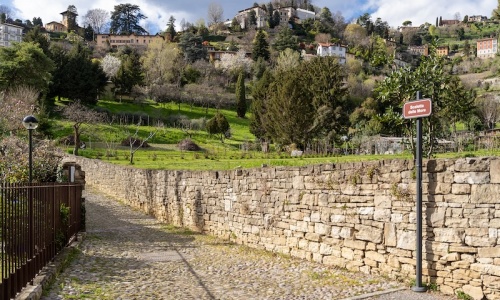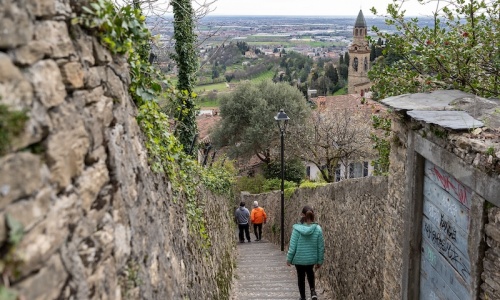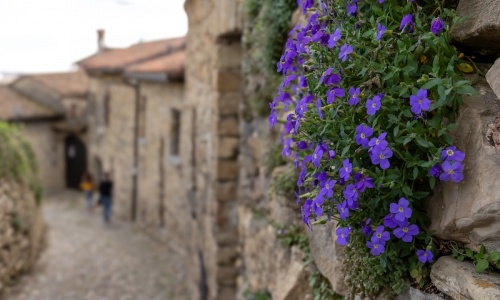This route features cobblestone streets and the typical stone stairways that wind along the hillsides, leading to panoramic spots surrounded by greenery and ancient homes.
The walk begins at the Italcementi Sports Center parking lot on Via dello Statuto and leads to the Castello di S. Vigilio. Families with small children are advised to use backpacks or baby carriers instead of strollers for a smoother and more enjoyable experience.

Starting from the Italcementi Sports Center parking lot, the first stairway encountered is the Scaletta delle More. It begins as a cobbled street and transforms into a staircase with 245 steps, surrounded by dry-stone walls.
This stairway leads to Borgo Canale, where one of the most picturesque views of the route can be enjoyed. Along the way, you will see beautiful villas with well-kept gardens, quiet streets, and alleys far from the traffic and noise of the city. This area offers a perfect view of the plains as well as Città Alta.
The route continues by turning right and then left onto Via S. Martino, where the Scaletta dello Scorlazzino begins.
Starting from the Italcementi Sports Center parking lot, the first stairway encountered is the Scaletta delle More. It begins as a cobbled street and transforms into a staircase with 245 steps, surrounded by dry-stone walls.
This stairway leads to Borgo Canale, where one of the most picturesque views of the route can be enjoyed. Along the way, you will see beautiful villas with well-kept gardens, quiet streets, and alleys far from the traffic and noise of the city. This area offers a perfect view of the plains as well as Città Alta.
The route continues by turning right and then left onto Via S. Martino, where the Scaletta dello Scorlazzino begins.

The Scaletta dello Scorlazzino is a combination of steps and cobblestones, bordered by dry-stone walls and tall cypress trees.
After about a kilometer of climbing, you will see the Tempio dei Caduti (Temple of the Fallen - war memorial) on the left, a must-see spot along with Via Sudorno, which leads to Scorlazzone, the continuation of Scorlazzino.
The atmosphere here is timeless, with a serene stillness that allows you to fully enjoy the panoramic view of the entire plain.
Scorlazzino and Scorlazzone are two of the most iconic stairways in Bergamo and are beloved by the locals. Surrounded by vegetable gardens, nature, and historic homes, they offer wonderful views from different parts of the city.
The Scaletta dello Scorlazzino is a combination of steps and cobblestones, bordered by dry-stone walls and tall cypress trees.
After about a kilometer of climbing, you will see the Tempio dei Caduti (Temple of the Fallen - war memorial) on the left, a must-see spot along with Via Sudorno, which leads to Scorlazzone, the continuation of Scorlazzino.
The atmosphere here is timeless, with a serene stillness that allows you to fully enjoy the panoramic view of the entire plain.
Scorlazzino and Scorlazzone are two of the most iconic stairways in Bergamo and are beloved by the locals. Surrounded by vegetable gardens, nature, and historic homes, they offer wonderful views from different parts of the city.
Continuing uphill on the Scaletta Scorlazzone to the 1.4 km mark, you will reach the Church of San Vigilio and just beyond that, the San Vigilio funicular. A stop at the terrace at the funicular’s exit is a must: it is the best panoramic viewpoint in the entire city. Further ahead, still with a slight incline, you will arrive at the Castello di San Vigilio, which offers an expansive view of the Bergamasque Alps on one side and the plains and Milan on the other.
At this point, you can begin descending toward Porta S. Alessandro. Just before reaching it, on the right, there is a short stairway that leads to the majestic Church of Santa Grata, where you can view a series of paintings depicting scenes with living skeletons, created by 19th-century artist Bonomini.
Continuing along the road, you will encounter the birthplace of Gaetano Donizetti, one of Bergamo’s most famous composers. From here, take a right onto Via Tre Armi.
Continuing uphill on the Scaletta Scorlazzone to the 1.4 km mark, you will reach the Church of San Vigilio and just beyond that, the San Vigilio funicular. A stop at the terrace at the funicular’s exit is a must: it is the best panoramic viewpoint in the entire city. Further ahead, still with a slight incline, you will arrive at the Castello di San Vigilio, which offers an expansive view of the Bergamasque Alps on one side and the plains and Milan on the other.
At this point, you can begin descending toward Porta S. Alessandro. Just before reaching it, on the right, there is a short stairway that leads to the majestic Church of Santa Grata, where you can view a series of paintings depicting scenes with living skeletons, created by 19th-century artist Bonomini.
Continuing along the road, you will encounter the birthplace of Gaetano Donizetti, one of Bergamo’s most famous composers. From here, take a right onto Via Tre Armi.

From Via Tre Armi, turn right onto Via degli Orti, and immediately to the left, you will find the final stairway of this route: Scaletta Fontanabrolo. With a few changes of direction and a cobbled surface, the Fontanabrolo stairway quickly leads to the endpoint: it reaches a steep slope of 30%. This rapid descent takes you right back to your starting point, Via dello Statuto.
From Via Tre Armi, turn right onto Via degli Orti, and immediately to the left, you will find the final stairway of this route: Scaletta Fontanabrolo. With a few changes of direction and a cobbled surface, the Fontanabrolo stairway quickly leads to the endpoint: it reaches a steep slope of 30%. This rapid descent takes you right back to your starting point, Via dello Statuto.